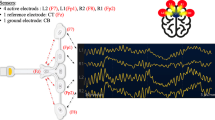Abstract
Thirteen (19.2%) of 68 at risk neonates in an intensive care nursery with one or more adverse perinatal clinical factors viz; prematurity (<37 wks), low birth weight (<2000 gm), hyperbilirubinemia requiring active intervention, birth anoxia, neonatal seizures, infections, aminoglycoside administration, and craniofacial malformations; were diagnosed to have hearing impairment (elevated auditory threshold) by BERA testing performed within the first six weeks of life at a mean conceptional (gestational age + age after birth) age of 40.2±0.6 wks. As against this, 20 healthy term neonates who were examined at a mean conceptional age of 40.4±0.8 weeks had a normal hearing threshold of 30 db nHL. Elevated auditory threshold was found more frequently in neonates with multiple clinical adverse factors than in those having single risk factor (6/13 Vs 7/55, p<0.001). On multiple logistic regression analysis, however, only 2 factors viz; hyperbilirubinemia at level exceeding indication for exchange transfusion and birth weight <1500 gm, were found to be significantly correlated with the hearing impairment in the affected neonates and in that order of importance. Prematurity, birth asphyxia, neonatal seizures, infections and aminoglycoside administration had no significant correlation with hearing impairment. Since most of the neonates admitted to the neonatal ICU have one or more identified adverse risk factors, their hearing screening by BERA at the time of discharge seems justified.
Similar content being viewed by others
References
Feinmesser M, Tell L, Levi H. Followup of 40,000 infants screened for hearing defect.Audiology 1982; 21: 197–203.
American Academy of Pediatrics, Joint Committee on Infant Hearing, Position statement.Pediatrics 1982; 70: 496.
Konigsmark BW.Genetic and Metabolic Deafness. Philadelphia; W.B. Saunders, 1976: p 419.
Hardy JB. Fetal consequences of maternal viral infections in pregnancy.Arch Otolaryngol 1973; 98: 218–227.
Crosse VM, Meyer TC, Jerrard JW. Kenicterus & prematurity.Arch Dis Child 1955; 30: 501–508.
Fisch L, Osborn DA. Congenital deafness & haemolytic disease of the newborn.Arch Dis Child 1954; 29: 309–316.
Flottorp G, Morley DE, Skatvedt M. The localization of hearing impairment in athetoids.Acta Otolaryngol 1957; 48: 404–414.
Schulman-Galambos C, Galambos R. Brainstem evoked response audiometry in newborn hearing screening.Arch Otolaryngol 1979; 105: 86–90.
Picton TW, Durieux-Smith A. Auditory evoked potentials in the assessment of hearing.Neurol Clin 1988; 6(4): 791–808.
Epstein CM. The use of brainstem auditory evoked potentials in the evaluation of the central nervous system.Neurol Clin 1988; 6(4): 771–789.
Despland P, Galambos R. The auditory brainstem response (ABR) is a useful diagnostic tool in intensive care nursery.Pediatr Res 1980; 14: 154–158.
Picton TW, Taylor MJ, Durieux-Smith A, Edwards CG. Brainstem auditory evoked potentials in pediatrics. In: Aminoff MJ, ed.Electro Diagnosis in Clinical Neurology, 2nd edn, New York: Churchill-Livingstone, 1986: pp 505–534.
Kramer SJ, Vertes DR, Condon M. Auditory brainstem responses and clinical followup of high risk infants.Pediatrics 1989; 83(3): 385–392.
Dubowitz LMS, Dubowitz V, Goldberg C. Clinical assessment of gestational age in the newborn infant.J Pediatr 1970; 77: 1–10.
Shannon DA, Felix JK, Krumholz A et al. Hearing screening of high risk newborn with brainstem auditory evoked potentials. A followup study.Pediatrics 1984; 73(1): 22–26.
Alberti PW, Hyde ML, Riko K. An evaluation of BERA for hearing screening in high risk neonates.Laryngoscope 1983; 93: 1115–1121.
Mjoen S, Langslet A, Tangsrud SE, Sundby A. Auditory brainstem response (ABR) in high risk neonates.Acta Pediatr Scand 1982; 71: 711–715.
Galambos R, Hicks G, Wilson MJ. Hearing loss in graduates of a tertiary intensive care nursery.Ear Hear 1982; 3: 87–90.
Bernard PA, Pechere JC. Hebert R. Altered objective audiometry in aminoglycosides treated human neonates.Arch Otorhino laryngol 1980; 228: 205–210.
Author information
Authors and Affiliations
Rights and permissions
About this article
Cite this article
Gupta, A.K., Anand, N.K. & Raj, H. Evaluation of risk factors for hearing impairment in at risk neonates by brainstem evoked response audiometry (BERA). Indian J Pediatr 58, 849–855 (1991). https://doi.org/10.1007/BF02825449
Issue Date:
DOI: https://doi.org/10.1007/BF02825449




